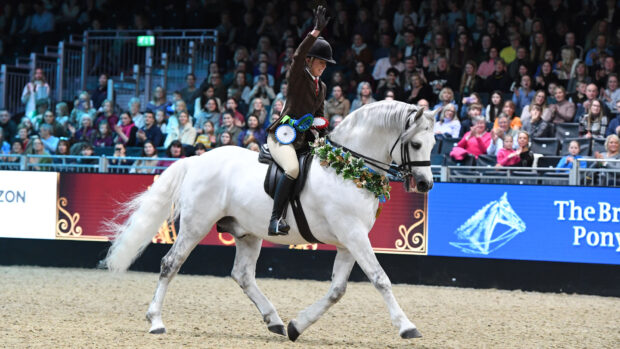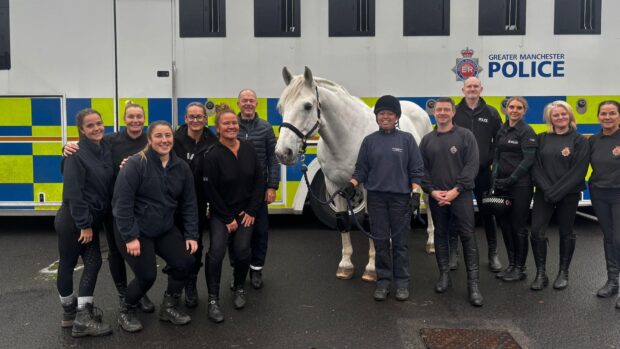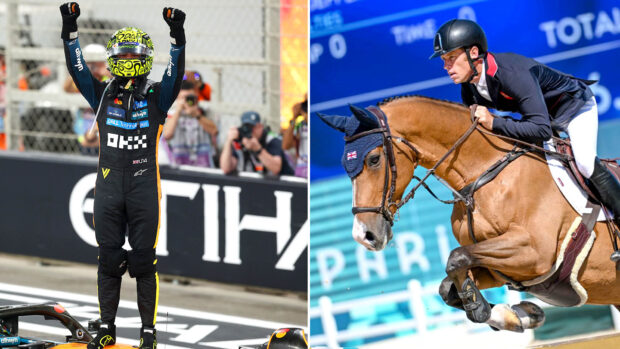If a rider feels unbalanced, how do they steady themselves? In most cases, it’ll be an unconscious reaction involving their hands. Being aware not just of how we hold the reins, but exactly what we do with our hands is crucial. And it might be that a subtle change in our rein-handling technique could improve our understanding of contact.
“Humans do everything with their hands; they are always in front of us,” says grand prix dressage rider and British Equestrian P3 coach, Charlie Hutton . “Instinctively, we go to our hands to secure ourselves, but when we ride, we have to be more conscious.”
A balanced rider is at liberty, as Charlie says, “to ride from the hindquarters”.
In other words, a balanced rider can deliver aids to their horse using different parts of their body independently to encourage him to travel forward in to the rein from the hindquarters. This isn’t possible if the rider becomes over-reliant on the rein as an aid not just to their horse, but to help maintain their own balance too.
Using the rein for balance interferes with maintaining the ideal feeling of connection in the rein, or contact – and is unlikely to be comfortable for the horse. But horse to horse, it’s hard to pinpoint precisely what the optimum feeling in the rein should be.
“To put it simply, it should feel like you have enough connection to communicate with your horse, but be light enough that you don’t meet with resistance,” says Charlie. “A true contact is one where the horse is comfortable with and following the rein – harmony and self-carriage should always be the rider’s goal.”
While contact and balance issues are best tackled with your trainer, Charlie recommends trying different rein-handling techniques when you’re schooling alone.
“Changing the way you hold the reins gives you a new perspective,” explains Charlie. “It might help raise awareness of an area of tension, for example, or highlight a way you could be using aids more effectively.”
You can use rein-handling exercises to test the quality of your contact, the security of your position and the effectiveness of your other aids.
“Think of them as tools and techniques at your disposal that will help you analyse the quality of your work,” he adds.
How to hold the reins in three simple exercises
{"content":"PGgzPkV4ZXJjaXNlIDE6IHRodW1iIGFuZCBmb3JlZmluZ2VyPC9oMz4KPHA+PGltZyBmZXRjaHByaW9yaXR5PSJoaWdoIiBkZWNvZGluZz0iYXN5bmMiIGNsYXNzPSJsYXp5bG9hZCBibHVyLXVwIGFsaWdubm9uZSBzaXplLWZ1bGwgd3AtaW1hZ2UtODkwNjkxIiBkYXRhLXByb2Nlc3NlZCBzcmM9Imh0dHBzOi8va2V5YXNzZXRzLnRpbWVpbmN1ay5uZXQvaW5zcGlyZXdwL2xpdmUvd3AtY29udGVudC91cGxvYWRzL3NpdGVzLzE0LzIwMTcvMDMvbmV3LWhoLXBsYWNlaG9sZGVyLTIwMHgyMDAucG5nIiBkYXRhLXNyYz0iaHR0cHM6Ly9rZXlhc3NldHMudGltZWluY3VrLm5ldC9pbnNwaXJld3AvbGl2ZS93cC1jb250ZW50L3VwbG9hZHMvc2l0ZXMvMTQvMjAyNS8wNC9JTUdfMzIwNC5qcGciIGFsdD0iUmVpbi1oYW5kbGluZyB0ZWNobmlxdWUiIHdpZHRoPSIxNDAwIiBoZWlnaHQ9Ijc4OCIgZGF0YS1zaXplcz0iYXV0byIgZGF0YS1zcmNzZXQ9Imh0dHBzOi8va2V5YXNzZXRzLnRpbWVpbmN1ay5uZXQvaW5zcGlyZXdwL2xpdmUvd3AtY29udGVudC91cGxvYWRzL3NpdGVzLzE0LzIwMjUvMDQvSU1HXzMyMDQuanBnIDE0MDB3LCBodHRwczovL2tleWFzc2V0cy50aW1laW5jdWsubmV0L2luc3BpcmV3cC9saXZlL3dwLWNvbnRlbnQvdXBsb2Fkcy9zaXRlcy8xNC8yMDI1LzA0L0lNR18zMjA0LTMwMHgxNjkuanBnIDMwMHcsIGh0dHBzOi8va2V5YXNzZXRzLnRpbWVpbmN1ay5uZXQvaW5zcGlyZXdwL2xpdmUvd3AtY29udGVudC91cGxvYWRzL3NpdGVzLzE0LzIwMjUvMDQvSU1HXzMyMDQtNjMweDM1NS5qcGcgNjMwdywgaHR0cHM6Ly9rZXlhc3NldHMudGltZWluY3VrLm5ldC9pbnNwaXJld3AvbGl2ZS93cC1jb250ZW50L3VwbG9hZHMvc2l0ZXMvMTQvMjAyNS8wNC9JTUdfMzIwNC0xMzV4NzYuanBnIDEzNXcsIGh0dHBzOi8va2V5YXNzZXRzLnRpbWVpbmN1ay5uZXQvaW5zcGlyZXdwL2xpdmUvd3AtY29udGVudC91cGxvYWRzL3NpdGVzLzE0LzIwMjUvMDQvSU1HXzMyMDQtMzIweDE4MC5qcGcgMzIwdywgaHR0cHM6Ly9rZXlhc3NldHMudGltZWluY3VrLm5ldC9pbnNwaXJld3AvbGl2ZS93cC1jb250ZW50L3VwbG9hZHMvc2l0ZXMvMTQvMjAyNS8wNC9JTUdfMzIwNC02MjB4MzQ5LmpwZyA2MjB3LCBodHRwczovL2tleWFzc2V0cy50aW1laW5jdWsubmV0L2luc3BpcmV3cC9saXZlL3dwLWNvbnRlbnQvdXBsb2Fkcy9zaXRlcy8xNC8yMDI1LzA0L0lNR18zMjA0LTkyMHg1MTguanBnIDkyMHcsIGh0dHBzOi8va2V5YXNzZXRzLnRpbWVpbmN1ay5uZXQvaW5zcGlyZXdwL2xpdmUvd3AtY29udGVudC91cGxvYWRzL3NpdGVzLzE0LzIwMjUvMDQvSU1HXzMyMDQtMTIyMHg2ODcuanBnIDEyMjB3IiBzaXplcz0iKG1heC13aWR0aDogMTQwMHB4KSAxMDB2dywgMTQwMHB4IiAvPjwvcD4KCjxwPjxzdHJvbmc+Rm9jdXMgb246PC9zdHJvbmc+IHF1YWxpdHkgb2YgY29udGFjdDwvcD4KPHA+SG9sZCB0aGUgcmVpbnMgc28gdGhlIGVuZCBhdHRhY2hlZCB0byB0aGUgYml0IGNvbWVzIG91dCBvZiB0aGUgdG9wIG9mIHlvdXIgaGFyZCBiZXR3ZWVuIHlvdXIgdGh1bWIgYW5kIGZvcmVmaW5nZXIuIFRoZSBsb29zZSBsb29wIGluIHRoZSByZWluIHNob3VsZCBydW4gZG93biB0aHJvdWdoIHlvdXIgZmlzdCB3aXRoIGFsbCB5b3VyIGZpbmdlcnMgY3VybGVkIGFyb3VuZCBpdCDigJMgZG9u4oCZdCBwdXQgaXQgYmFjayB0aHJvdWdoIHRoZSBnYXAgYmV0d2VlbiB5b3VyIHJpbmcgZmluZ2VyIGFuZCBsaXR0bGUgZmluZ2VyLjwvcD4KPHA+PHN0cm9uZz5Ib3cgaXQgaGVscHM8L3N0cm9uZz48L3A+CjxwPuKAnE15IGdyYW5kbW90aGVyIHRhdWdodCBtZSB0aGlzIHRlY2huaXF1ZSzigJ0gZXhwbGFpbnMgQ2hhcmxpZS4g4oCcU2hlIHRvbGQgbWUgaXQgb3JpZ2luYXRlZCBmcm9tIHRoZSBDYWRyZSBOb2lyLCB0aGUgRnJlbmNoIGNsYXNzaWNhbCB0cmFpbmluZyBjZW50cmUu4oCdPC9wPgo8cD5BY2NvcmRpbmcgdG8gQ2hhcmxpZSwgaXTigJlzIHNvbWV0aGluZyA8YSBocmVmPSIvdGFnL2NhcmwtaGVzdGVyIiB0YXJnZXQ9Il9ibGFuayIgcmVsPSJub2ZvbGxvdyBub29wZW5lciI+Q2FybCBIZXN0ZXI8L2E+IHVzZXMgdG8gaGVscCBob3JzZXMgd2l0aCBsaWdodG5lc3MgYW5kIHNlbGYtY2FycmlhZ2UuIFdpbGxpYW0gRm94LVBpdHQgaGFzIGFsc28gYmVlbiBzZWVuIHVzaW5nIHRoaXMgcmVpbiBwb3NpdGlvbiBvbiBzb21lIGhvcnNlcyBkdXJpbmcgdGhlIGNyb3NzLWNvdW50cnkgcGhhc2UuPC9wPgo8cD7igJxJdCBhbHNvIGNoYW5nZXMgdGhlIG11c2NsZXMgeW914oCZcmUgdXNpbmcgaW4geW91ciBmb3JlYXJtLCBzbyBpdCBoZWxwcyB5b3UgdG8gYmUgbW9yZSBlbGFzdGljIGFuZCBsZXNzIHJlc3RyaWN0aXZlIHRocm91Z2ggeW91ciBlbGJvdyzigJ0gQ2hhcmxpZSBleHBsYWlucy48L3A+CjxwPjxzdHJvbmc+V2hhdCB0byBsb29rIG91dCBmb3I8L3N0cm9uZz48L3A+CjxwPuKAnFdoZW4geW914oCZcmUgbm90IHVzZWQgdG8gaG9sZGluZyB0aGUgcmVpbiBsaWtlIHRoYXQsIHlvdXIgYXJtIHdpbGwgZmF0aWd1ZSBhIGxpdHRsZSBiaXQgc29vbmVyIHRoYW4gdXN1YWws4oCdIHdhcm5zIENoYXJsaWUsIOKAnHNvIHdhdGNoIG91dCBmb3IgZ2V0dGluZyB0aXJlZCBhbmQgbG9zaW5nIGZvcm0u4oCdPC9wPgo8aDM+RXhlcmNpc2UgMjogaGFsZiBicmlkZ2luZyB0aGUgcmVpbnM8L2gzPgo8cD48aW1nIGRlY29kaW5nPSJhc3luYyIgY2xhc3M9Imxhenlsb2FkIGJsdXItdXAgYWxpZ25ub25lIHNpemUtZnVsbCB3cC1pbWFnZS04OTA0NTUiIGRhdGEtcHJvY2Vzc2VkIHNyYz0iaHR0cHM6Ly9rZXlhc3NldHMudGltZWluY3VrLm5ldC9pbnNwaXJld3AvbGl2ZS93cC1jb250ZW50L3VwbG9hZHMvc2l0ZXMvMTQvMjAxNy8wMy9uZXctaGgtcGxhY2Vob2xkZXItMjAweDIwMC5wbmciIGRhdGEtc3JjPSJodHRwczovL2tleWFzc2V0cy50aW1laW5jdWsubmV0L2luc3BpcmV3cC9saXZlL3dwLWNvbnRlbnQvdXBsb2Fkcy9zaXRlcy8xNC8yMDI1LzA0L0hBSDAwLmxiX0ZhcndheV9mYXJtX3N0b2NrX2ltYWdlc19mdXR1cmVvd25zX2VtbWFfaGVycm9kLkZBUldBWV9GQVJNX0ZVVFVSRV9PV05TX0VNTUFfSEVSUk9EMjAyNTA0MDJfMzY1OS5qcGciIGFsdD0iIiB3aWR0aD0iMTQwMCIgaGVpZ2h0PSI3ODgiIGRhdGEtc2l6ZXM9ImF1dG8iIGRhdGEtc3Jjc2V0PSJodHRwczovL2tleWFzc2V0cy50aW1laW5jdWsubmV0L2luc3BpcmV3cC9saXZlL3dwLWNvbnRlbnQvdXBsb2Fkcy9zaXRlcy8xNC8yMDI1LzA0L0hBSDAwLmxiX0ZhcndheV9mYXJtX3N0b2NrX2ltYWdlc19mdXR1cmVvd25zX2VtbWFfaGVycm9kLkZBUldBWV9GQVJNX0ZVVFVSRV9PV05TX0VNTUFfSEVSUk9EMjAyNTA0MDJfMzY1OS5qcGcgMTQwMHcsIGh0dHBzOi8va2V5YXNzZXRzLnRpbWVpbmN1ay5uZXQvaW5zcGlyZXdwL2xpdmUvd3AtY29udGVudC91cGxvYWRzL3NpdGVzLzE0LzIwMjUvMDQvSEFIMDAubGJfRmFyd2F5X2Zhcm1fc3RvY2tfaW1hZ2VzX2Z1dHVyZW93bnNfZW1tYV9oZXJyb2QuRkFSV0FZX0ZBUk1fRlVUVVJFX09XTlNfRU1NQV9IRVJST0QyMDI1MDQwMl8zNjU5LTMwMHgxNjkuanBnIDMwMHcsIGh0dHBzOi8va2V5YXNzZXRzLnRpbWVpbmN1ay5uZXQvaW5zcGlyZXdwL2xpdmUvd3AtY29udGVudC91cGxvYWRzL3NpdGVzLzE0LzIwMjUvMDQvSEFIMDAubGJfRmFyd2F5X2Zhcm1fc3RvY2tfaW1hZ2VzX2Z1dHVyZW93bnNfZW1tYV9oZXJyb2QuRkFSV0FZX0ZBUk1fRlVUVVJFX09XTlNfRU1NQV9IRVJST0QyMDI1MDQwMl8zNjU5LTYzMHgzNTUuanBnIDYzMHcsIGh0dHBzOi8va2V5YXNzZXRzLnRpbWVpbmN1ay5uZXQvaW5zcGlyZXdwL2xpdmUvd3AtY29udGVudC91cGxvYWRzL3NpdGVzLzE0LzIwMjUvMDQvSEFIMDAubGJfRmFyd2F5X2Zhcm1fc3RvY2tfaW1hZ2VzX2Z1dHVyZW93bnNfZW1tYV9oZXJyb2QuRkFSV0FZX0ZBUk1fRlVUVVJFX09XTlNfRU1NQV9IRVJST0QyMDI1MDQwMl8zNjU5LTEzNXg3Ni5qcGcgMTM1dywgaHR0cHM6Ly9rZXlhc3NldHMudGltZWluY3VrLm5ldC9pbnNwaXJld3AvbGl2ZS93cC1jb250ZW50L3VwbG9hZHMvc2l0ZXMvMTQvMjAyNS8wNC9IQUgwMC5sYl9GYXJ3YXlfZmFybV9zdG9ja19pbWFnZXNfZnV0dXJlb3duc19lbW1hX2hlcnJvZC5GQVJXQVlfRkFSTV9GVVRVUkVfT1dOU19FTU1BX0hFUlJPRDIwMjUwNDAyXzM2NTktMzIweDE4MC5qcGcgMzIwdywgaHR0cHM6Ly9rZXlhc3NldHMudGltZWluY3VrLm5ldC9pbnNwaXJld3AvbGl2ZS93cC1jb250ZW50L3VwbG9hZHMvc2l0ZXMvMTQvMjAyNS8wNC9IQUgwMC5sYl9GYXJ3YXlfZmFybV9zdG9ja19pbWFnZXNfZnV0dXJlb3duc19lbW1hX2hlcnJvZC5GQVJXQVlfRkFSTV9GVVRVUkVfT1dOU19FTU1BX0hFUlJPRDIwMjUwNDAyXzM2NTktNjIweDM0OS5qcGcgNjIwdywgaHR0cHM6Ly9rZXlhc3NldHMudGltZWluY3VrLm5ldC9pbnNwaXJld3AvbGl2ZS93cC1jb250ZW50L3VwbG9hZHMvc2l0ZXMvMTQvMjAyNS8wNC9IQUgwMC5sYl9GYXJ3YXlfZmFybV9zdG9ja19pbWFnZXNfZnV0dXJlb3duc19lbW1hX2hlcnJvZC5GQVJXQVlfRkFSTV9GVVRVUkVfT1dOU19FTU1BX0hFUlJPRDIwMjUwNDAyXzM2NTktOTIweDUxOC5qcGcgOTIwdywgaHR0cHM6Ly9rZXlhc3NldHMudGltZWluY3VrLm5ldC9pbnNwaXJld3AvbGl2ZS93cC1jb250ZW50L3VwbG9hZHMvc2l0ZXMvMTQvMjAyNS8wNC9IQUgwMC5sYl9GYXJ3YXlfZmFybV9zdG9ja19pbWFnZXNfZnV0dXJlb3duc19lbW1hX2hlcnJvZC5GQVJXQVlfRkFSTV9GVVRVUkVfT1dOU19FTU1BX0hFUlJPRDIwMjUwNDAyXzM2NTktMTIyMHg2ODcuanBnIDEyMjB3IiBzaXplcz0iKG1heC13aWR0aDogMTQwMHB4KSAxMDB2dywgMTQwMHB4IiAvPjwvcD4KPHA+PHN0cm9uZz5Gb2N1cyBvbjo8L3N0cm9uZz4gc3RhYmlsaXR5IG9mIHlvdXIgcG9zaXRpb24sIGVmZmVjdGl2ZW5lc3Mgb2Ygb3RoZXIgYWlkczwvcD4KPHA+QnJpZGdpbmcgdGhlIHJlaW5zIG1lYW5zIGxvb3BpbmcgeW91ciBsZWZ0IHJlaW4gaW50byB5b3VyIHJpZ2h0IGhhbmQgYW5kIHlvdXIgcmlnaHQgcmVpbiBpbnRvIHlvdXIgbGVmdCBoYW5kLCBzbyBlYWNoIGhhbmQgaG9sZHMgdGhlIHJlaW4gdHdpY2UuIFRoZSByZWlucyB3aWxsIG1ha2UgYSBjaXJjbGUgc2hhcGUgYXJvdW5kIHlvdXIgaGFuZC4gVGhpcyBjYW4gYmUgYSB1c2VmdWwgdGVjaG5pcXVlIHdoZW4gcmlkaW5nIGhvcnNlcyB0aGF0IHRlbmQgdG8gcHVsbCBkb3duIGF0IHNwZWVkLjwvcD4KPHA+QWx0ZXJuYXRpdmVseSwgaW5zdGVhZCBvZiBicmlkZ2luZyBib3RoIHJlaW5zLCBicmlkZ2Ugb25lIHNpZGUgYXQgYSB0aW1lLiBGb3IgZXhhbXBsZSwgYnJpZGdlIHRoZSBsZWZ0IHJlaW4gc28geW91ciByaWdodCBoYW5kIGlzIGhvbGRpbmcgdGhlIHJpZ2h0IGFuZCBsZWZ0IHJlaW5zLCBhbmQgeW91ciBsZWZ0IGhhbmQgaG9sZHMgdGhlIGxlZnQgcmVpbiBvbmx5LiBJZiB5b3UgbG9vayBkb3duLCB5b3VyIGhhbmRzIHdpbGwgYmUgY29ubmVjdGVkIGJ5IHRoZSBsZWZ0IHJlaW4uPC9wPgo8cD48c3Ryb25nPkhvdyBpdCBoZWxwczwvc3Ryb25nPjwvcD4KPHA+4oCcSGFsZiBicmlkZ2luZyB0aGUgcmVpbnMgZ2l2ZXMgeW91IGEgYml0IG1vcmUgc3RhYmlsaXR5LOKAnSBzYXlzIENoYXJsaWUuIOKAnFlvdeKAmXZlIGFkZGVkIGFub3RoZXIgcG9pbnQgb2YgY29udGFjdCB0byBoZWxwIHlvdSBrZWVwIHlvdXIgaGFuZHMgc3RhYmxlIGFuZCBhcyBhIHBhaXIuPC9wPgo8cD7igJxCZWNhdXNlIHlvdXIgaGFuZHMgYXJlIHBhaXJlZCB0b2dldGhlciBhZ2FpbiwgeW91IG11c3QgZG8gbW9yZSB3aXRoIHlvdXIgYm9keSzigJ0gaGUgY29udGludWVzLjwvcD4KPHA+SXTigJlzIGVzcGVjaWFsbHkgZ29vZCBmb3IgcmlkZXJzIHdobyBhcmUgb3Zlci1yZWxpYW50IG9uIHRoZWlyIHJlaW4gYWlkcyB3aGlsZSBuZWdsZWN0aW5nIHRoZSByZXN0IG9mIHRoZWlyIGJvZHkuPC9wPgo8cD7igJxJdCBtYWtlcyB5b3UgbW9yZSBhd2FyZSBvZiBob3cgdG8gdHVybiB0aHJvdWdoIHlvdXIgc2hvdWxkZXJzLCBmb3IgZXhhbXBsZSwgb3IgdGhlIHVzZSBvZiB5b3VyIG91dHNpZGUgYWlkcyzigJ0gaGUgc2F5cy48L3A+CjxwPjxzdHJvbmc+V2hhdCB0byBsb29rIG91dCBmb3I8L3N0cm9uZz48L3A+CjxwPlRoaXMgZXhlcmNpc2UgbWlnaHQgcmV2ZWFsIGFyZWFzIHRvIHdvcmsgb24gaW4geW91ciBwb3NpdGlvbiwgZm9yIGV4YW1wbGUgaWYgeW91IGNvbGxhcHNlIHRocm91Z2ggeW91ciBib2R5IGFuZCBkb27igJl0IHR1cm4geW91ciBzaG91bGRlcnMuIElmIHVzaW5nIHlvdXIgYm9keSBzdWRkZW5seSBmZWVscyBkaWZmaWN1bHQsIHRoaXMgbWlnaHQgaW5kaWNhdGUgYSByZWxpYW5jZSBvbiB5b3VyIHJlaW4gYWlkcy48L3A+CjxwPkJyaWRnaW5nIHRoZSByZWlucyBjYW4gYWxzbyBlbXBoYXNpc2UgdGhlIGRvbWluYW5jZSBvZiBvbmUgaGFuZCBvdmVyIHRoZSBvdGhlci4gRXhwZXJpbWVudCB3aXRoIHdoaWNoIGhhbmQgZm9ybXMgdGhlIGJyaWRnZSBhbmQgYW5hbHlzZSB0aGUgZmVlbGluZy48L3A+CjxwPkZpbmFsbHksIHlvdSBtaWdodCBuZWVkIHRvIGFkanVzdCB5b3VyIHJlaW4gbGVuZ3RoIGFuZCB0aGUgY2FycmlhZ2Ugb2YgeW91ciBoYW5kcy4g4oCcTWFueSBwZW9wbGUgcmlkZSB3aXRoIHRoZWlyIHJlaW5zIHRvbyBsb25nLCB3aGljaCB0aGlzIHdpbGwgaGlnaGxpZ2h0LOKAnSBhZHZpc2VzIENoYXJsaWUuPC9wPgo8aDM+RXhlcmNpc2UgMzogb25lLWhhbmRlZCBsYXRlcmFsIHdvcms8L2gzPgo8ZGl2IGlkPSJhdHRhY2htZW50Xzg5MDQ1MyIgc3R5bGU9IndpZHRoOiAxNDEwcHgiIGNsYXNzPSJ3cC1jYXB0aW9uIGFsaWdubm9uZSI+PGltZyBkZWNvZGluZz0iYXN5bmMiIGFyaWEtZGVzY3JpYmVkYnk9ImNhcHRpb24tYXR0YWNobWVudC04OTA0NTMiIGNsYXNzPSJsYXp5bG9hZCBibHVyLXVwIHNpemUtZnVsbCB3cC1pbWFnZS04OTA0NTMiIGRhdGEtcHJvY2Vzc2VkIHNyYz0iaHR0cHM6Ly9rZXlhc3NldHMudGltZWluY3VrLm5ldC9pbnNwaXJld3AvbGl2ZS93cC1jb250ZW50L3VwbG9hZHMvc2l0ZXMvMTQvMjAxNy8wMy9uZXctaGgtcGxhY2Vob2xkZXItMjAweDIwMC5wbmciIGRhdGEtc3JjPSJodHRwczovL2tleWFzc2V0cy50aW1laW5jdWsubmV0L2luc3BpcmV3cC9saXZlL3dwLWNvbnRlbnQvdXBsb2Fkcy9zaXRlcy8xNC8yMDI1LzA0L0hBSDAwLmxiX0ZhcndheV9mYXJtX3N0b2NrX2ltYWdlc19mdXR1cmVvd25zX2VtbWFfaGVycm9kLkZBUldBWV9GQVJNX0ZVVFVSRV9PV05TX0VNTUFfSEVSUk9EMjAyNTA0MDJfMzQwMi5qcGciIGFsdD0iUmlkZXIgb24gY2hlc3RudXQgaG9yc2UgcmlkaW5nIHdpdGggb25lIGhhbmQsIGFuIGV4ZXJjaXNlIGluIGhvdyB0byBob2xkIHRoZSByZWlucyIgd2lkdGg9IjE0MDAiIGhlaWdodD0iNzg4IiBkYXRhLXNpemVzPSJhdXRvIiBkYXRhLXNyY3NldD0iaHR0cHM6Ly9rZXlhc3NldHMudGltZWluY3VrLm5ldC9pbnNwaXJld3AvbGl2ZS93cC1jb250ZW50L3VwbG9hZHMvc2l0ZXMvMTQvMjAyNS8wNC9IQUgwMC5sYl9GYXJ3YXlfZmFybV9zdG9ja19pbWFnZXNfZnV0dXJlb3duc19lbW1hX2hlcnJvZC5GQVJXQVlfRkFSTV9GVVRVUkVfT1dOU19FTU1BX0hFUlJPRDIwMjUwNDAyXzM0MDIuanBnIDE0MDB3LCBodHRwczovL2tleWFzc2V0cy50aW1laW5jdWsubmV0L2luc3BpcmV3cC9saXZlL3dwLWNvbnRlbnQvdXBsb2Fkcy9zaXRlcy8xNC8yMDI1LzA0L0hBSDAwLmxiX0ZhcndheV9mYXJtX3N0b2NrX2ltYWdlc19mdXR1cmVvd25zX2VtbWFfaGVycm9kLkZBUldBWV9GQVJNX0ZVVFVSRV9PV05TX0VNTUFfSEVSUk9EMjAyNTA0MDJfMzQwMi0zMDB4MTY5LmpwZyAzMDB3LCBodHRwczovL2tleWFzc2V0cy50aW1laW5jdWsubmV0L2luc3BpcmV3cC9saXZlL3dwLWNvbnRlbnQvdXBsb2Fkcy9zaXRlcy8xNC8yMDI1LzA0L0hBSDAwLmxiX0ZhcndheV9mYXJtX3N0b2NrX2ltYWdlc19mdXR1cmVvd25zX2VtbWFfaGVycm9kLkZBUldBWV9GQVJNX0ZVVFVSRV9PV05TX0VNTUFfSEVSUk9EMjAyNTA0MDJfMzQwMi02MzB4MzU1LmpwZyA2MzB3LCBodHRwczovL2tleWFzc2V0cy50aW1laW5jdWsubmV0L2luc3BpcmV3cC9saXZlL3dwLWNvbnRlbnQvdXBsb2Fkcy9zaXRlcy8xNC8yMDI1LzA0L0hBSDAwLmxiX0ZhcndheV9mYXJtX3N0b2NrX2ltYWdlc19mdXR1cmVvd25zX2VtbWFfaGVycm9kLkZBUldBWV9GQVJNX0ZVVFVSRV9PV05TX0VNTUFfSEVSUk9EMjAyNTA0MDJfMzQwMi0xMzV4NzYuanBnIDEzNXcsIGh0dHBzOi8va2V5YXNzZXRzLnRpbWVpbmN1ay5uZXQvaW5zcGlyZXdwL2xpdmUvd3AtY29udGVudC91cGxvYWRzL3NpdGVzLzE0LzIwMjUvMDQvSEFIMDAubGJfRmFyd2F5X2Zhcm1fc3RvY2tfaW1hZ2VzX2Z1dHVyZW93bnNfZW1tYV9oZXJyb2QuRkFSV0FZX0ZBUk1fRlVUVVJFX09XTlNfRU1NQV9IRVJST0QyMDI1MDQwMl8zNDAyLTMyMHgxODAuanBnIDMyMHcsIGh0dHBzOi8va2V5YXNzZXRzLnRpbWVpbmN1ay5uZXQvaW5zcGlyZXdwL2xpdmUvd3AtY29udGVudC91cGxvYWRzL3NpdGVzLzE0LzIwMjUvMDQvSEFIMDAubGJfRmFyd2F5X2Zhcm1fc3RvY2tfaW1hZ2VzX2Z1dHVyZW93bnNfZW1tYV9oZXJyb2QuRkFSV0FZX0ZBUk1fRlVUVVJFX09XTlNfRU1NQV9IRVJST0QyMDI1MDQwMl8zNDAyLTYyMHgzNDkuanBnIDYyMHcsIGh0dHBzOi8va2V5YXNzZXRzLnRpbWVpbmN1ay5uZXQvaW5zcGlyZXdwL2xpdmUvd3AtY29udGVudC91cGxvYWRzL3NpdGVzLzE0LzIwMjUvMDQvSEFIMDAubGJfRmFyd2F5X2Zhcm1fc3RvY2tfaW1hZ2VzX2Z1dHVyZW93bnNfZW1tYV9oZXJyb2QuRkFSV0FZX0ZBUk1fRlVUVVJFX09XTlNfRU1NQV9IRVJST0QyMDI1MDQwMl8zNDAyLTkyMHg1MTguanBnIDkyMHcsIGh0dHBzOi8va2V5YXNzZXRzLnRpbWVpbmN1ay5uZXQvaW5zcGlyZXdwL2xpdmUvd3AtY29udGVudC91cGxvYWRzL3NpdGVzLzE0LzIwMjUvMDQvSEFIMDAubGJfRmFyd2F5X2Zhcm1fc3RvY2tfaW1hZ2VzX2Z1dHVyZW93bnNfZW1tYV9oZXJyb2QuRkFSV0FZX0ZBUk1fRlVUVVJFX09XTlNfRU1NQV9IRVJST0QyMDI1MDQwMl8zNDAyLTEyMjB4Njg3LmpwZyAxMjIwdyIgc2l6ZXM9IihtYXgtd2lkdGg6IDE0MDBweCkgMTAwdncsIDE0MDBweCIgLz48cCBpZD0iY2FwdGlvbi1hdHRhY2htZW50LTg5MDQ1MyIgY2xhc3M9IndwLWNhcHRpb24tdGV4dCI+VGFraW5nIHRoZSBpbnNpZGUgaGFuZCBvZmYgdGhlIHJlaW5zIHRlYWNoZXMgeW91IHRvIHVzZSB5b3VyIGxlZ3MgYW5kIGJvZHkgYWlkcyBhcyB3ZWxsIGFzIG9wZW5pbmcgdXAgdGhlIHNob3VsZGVycy4gQ3JlZGl0OiBFbW1hIEhlcnJvZCBQaG90b2dyYXBoeTwvcD48L2Rpdj4KPHA+PHN0cm9uZz5Gb2N1cyBvbjo8L3N0cm9uZz4gZWZmZWN0aXZlbmVzcyBvZiBvdGhlciBhaWRzLCBxdWFsaXR5IG9mIGNvbnRhY3Q8L3A+CjxwPlRha2UgdGhlIHJlaW5zIGluIHlvdXIgb3V0c2lkZSBoYW5kOyB0aGUgaW5zaWRlIGhhbmQgZHJvcHMgdG8geW91ciBzaWRlLiBCZWdpbiB3aXRoIGJhc2ljIHNoYXBlcyBzdWNoIGFzIDIwbSBjaXJjbGVzIGFuZCBjaGFuZ2VzIG9mIHJlaW4uPC9wPgo8cD5JbnRyb2R1Y2Ugc2ltcGxlIGxhdGVyYWwgd29yaywgc3VjaCBhcyBsZWcteWllbGQgZnJvbSB0aGUgwr4gbGluZSB0byB0aGUgdHJhY2sgb3Igc2hvdWxkZXItZm9yZS9zaG91bGRlci1pbiB1cCB0aGUgbG9uZyBzaWRlLjwvcD4KPHA+RW5zdXJlIHlvdSByZXBlYXQgb24gdGhlIG9wcG9zaXRlIHJlaW4sIHN3aXRjaGluZyBoYW5kcyBzbyB5b3XigJlyZSBhbHdheXMgaG9sZGluZyB0aGUgcmVpbnMgaW4gdGhlIG91dHNpZGUgaGFuZC48L3A+CjxwPjxzdHJvbmc+SG93IGl0IGhlbHBzPC9zdHJvbmc+PC9wPgo8cD5UaGlzIGlzIGEgZ29vZCBmb2xsb3ctdXAgdG8gdGhlIGhhbGYgYnJpZGdlIGV4ZXJjaXNlLCB3aGljaCBoYXMgYWxyZWFkeSBlc3RhYmxpc2hlZCBob3cgdG8gaG9sZCBib3RoIHJlaW5zIGluIG9uZSBoYW5kLjwvcD4KPHA+4oCcRHJvcHBpbmcgeW91ciBpbnNpZGUgaGFuZCBoZWxwcyB5b3Ugb3BlbiB1cCB5b3VyIHNob3VsZGVycyzigJ0gc2F5cyBDaGFybGllLCDigJxhbmQgYWxsb3dzIHlvdSB0byB0dXJuIGluIHRoZSBkaXJlY3Rpb24gb2YgdGhlIG1vdmVtZW50IG1vcmUsIHdoaWNoIGlzIGhlbHBmdWwuPC9wPgo8cD7igJxSZXN0cmljdGluZyB0byBvbmUgaGFuZCBhbHNvIG1ha2VzIHlvdSBmb2N1cyBvbiBob3cgdG8gZ3VpZGUgeW91ciBob3JzZS4gTm93IHRoYXQgeW91IGNhbuKAmXQgdXNlIHRoZSByZWlucyBhcyBmcmVlbHkgdG8gc3RlZXIsIGhvdyBlZmZlY3RpdmUgYXJlIHlvdXIgbGVnIGFuZCBib2R5IGFpZHM\/4oCdPC9wPgo8cD48c3Ryb25nPldoYXQgdG8gbG9vayBvdXQgZm9yPC9zdHJvbmc+PC9wPgo8cD7igJxUaGlzIGV4ZXJjaXNlIHNoaW5lcyBhIHNwb3RsaWdodCBvbiBob3cgZ29vZCB5b3VyIGNvbnRhY3QgaXMs4oCdIHNheXMgQ2hhcmxpZS4g4oCcSXQgcmFpc2VzIGFuIGF3YXJlbmVzcyBvZiB3aGF0IHlvdSBuZWVkIHRvIGRvIHRvIG1haW50YWluIHRoZSBjb25uZWN0aW9uIG5vdyB5b3XigJlyZSByZXN0cmljdGVkLuKAnTwvcD4KPHA+VGhlIHF1YWxpdHkgb2YgeW91ciBsYXRlcmFsIHdvcmsgbWlnaHQgYWxzbyBiZSBjb21wcm9taXNlZCwgc2hvd2luZyB5b3Ugd2hlcmUgdG8gbWFrZSBpbXByb3ZlbWVudHMuPC9wPgo8ZGl2IGNsYXNzPSJpbmplY3Rpb24iPjwvZGl2Pgo8cD7igJxGb3IgZXhhbXBsZSwgc2hvdWxkZXItaW4gc2hvdWxkIGJlIGRvbmUgZnJvbSB0aGUgaW5zaWRlIGxlZyB0byBsaWZ0IGFuZCBlbmdhZ2UgdGhlIGhvcnNlLOKAnSBzYXlzIENoYXJsaWUuIOKAnFRoZW4sIHRoZSBvdXRzaWRlIHJlaW4gc2VjdXJlcyBoaW0uPC9wPgo8cD7igJxXaGVuIGEgcmlkZXIgZG9lcyBzaG91bGRlci1pbiBvbmUtaGFuZGVkLCB5b3Ugb2Z0ZW4gc2VlIGhvcnNlcyBmYWxsIHRvIGEgbWV0cmUgdG8gdGhlIGluc2lkZSwgd2hpY2ggc2hvd3MgdGhleSBoYXZlIGJlZW4gdXNpbmcgdGhlIGluc2lkZSByZWluIHRvIGJhbGFuY2Uu4oCdPC9wPgo8cD4K"}
Did you enjoy reading this? You may also like to read…
Kylie Roddy schooling at home.
Credit: Andrew Sydenham for Future Publishing
The instruction to “take away and cross your stirrups” may signal hard work, but these exercises pay dividends.
Credit: Emma Herrod
Credit: Jess Photography
Harry uses small fences or cavaletti to help the horses jump into a more expressive change without over-reacting to the aids.
Credit: Jess Photography
Stay in touch with all the news in the run-up to and throughout the major shows and events during 2025 and beyond with a Horse & Hound subscription. Subscribe today for all you need to know ahead of these major events, plus online reports on the action as it happens from our expert team of reporters and in-depth analysis in our special commemorative magazines. Have a subscription already? Set up your unlimited website access now









